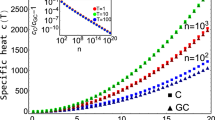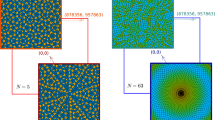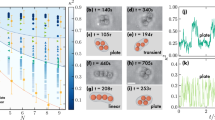Abstract
RANDOM packings of spheres serve as models for a variety of noncrystalline particulate and molecular aggregates, some of which, for example the amorphous phases of metals and alloys, offer abundant possibilities for the comparison of theory and experiment1–4. Nevertheless there remain significant discrepancies between the measured structural characteristics of real systems and the geometrical models considered by Bernal5, Cohen and Turnbull6 and others to be prototypes for the simple vitreous state. The most enduring of these is perhaps the difference in position and intensity between the two components of the split second peak in the radial distribution function observed in actual and artificial systems2–4. Attempts to remove this disagreement by variation of the algorithm used in computer-simulated packings have only been partially successful. In particular Sadoc et al.2 have noted that it is relatively easy to build in strong local density inhomogeneities associated with icosahedral arrangements7,8 and Connell has experimented with the packing of compressible spheres, showing that significant shifts in the radial distribution function result from the softening of the interatomic potential9.
This is a preview of subscription content, access via your institution
Access options
Subscribe to this journal
Receive 51 print issues and online access
$199.00 per year
only $3.90 per issue
Buy this article
- Purchase on Springer Link
- Instant access to full article PDF
Prices may be subject to local taxes which are calculated during checkout
Similar content being viewed by others
References
Cargill, G. S., J. appl Phys., 41, 12–29 (1970).
Sadoc, J. F., Dixmier, J., and Guinier, A., J. Noncryst. Solids, 12, 46–60 (1973).
Finney, J. L., J. Phys. Colloq., 36, C2 1–11 (1975).
Leung, P. K., and Wright, J. G., Phil. Mag., 30, 185–194 (1974); 30, 995–1008 (1974).
Bernal, J. D., Proc. R. Soc., A 280, 299–322 (1964).
Cohen, M. H., and Turnbull, D., Nature, 203, 964 (1964).
Frank, F. C., Proc. R. Soc., A 215, 43–46 (1952).
Frank, F. C., and Kasper, J. S., Acta Crystallogr., 11, 184–190 (1958).
Connell, G. A. N., Solid State Commun., 16, 109–112 (1975).
Finney, J. L., Proc. R. Soc., A 319, 495–507 (1970).
Hoare, M. R., and Pal, P., J. Cryst. Growth, 17, 77–96 (1972).
Fletcher, R., and Reeves, C. M., Computer J., 7, 149–154 (1964).
Mason, G., Nature, 217, 733–735 (1968).
Author information
Authors and Affiliations
Rights and permissions
About this article
Cite this article
BARKER, J., HOARE, M. & FINNEY, J. Relaxation of the Bernal model. Nature 257, 120–122 (1975). https://doi.org/10.1038/257120a0
Received:
Accepted:
Issue Date:
DOI: https://doi.org/10.1038/257120a0
This article is cited by
-
Low lying structural instabilities and entropy of monoatomic liquids
Zeitschrift f�r Physik B Condensed Matter (1989)
-
Atomic configurations in close-packed lennard-jones systems
Journal of Structural Chemistry (1987)
-
Study of the structure of simple liquids and amorphous solids by statistical geometry methods
Journal of Structural Chemistry (1987)
-
Icosahedral coordination of atoms in simple liquids
Journal of Structural Chemistry (1987)
-
Particle motion in glasses
Proceedings / Indian Academy of Sciences (1985)
Comments
By submitting a comment you agree to abide by our Terms and Community Guidelines. If you find something abusive or that does not comply with our terms or guidelines please flag it as inappropriate.



